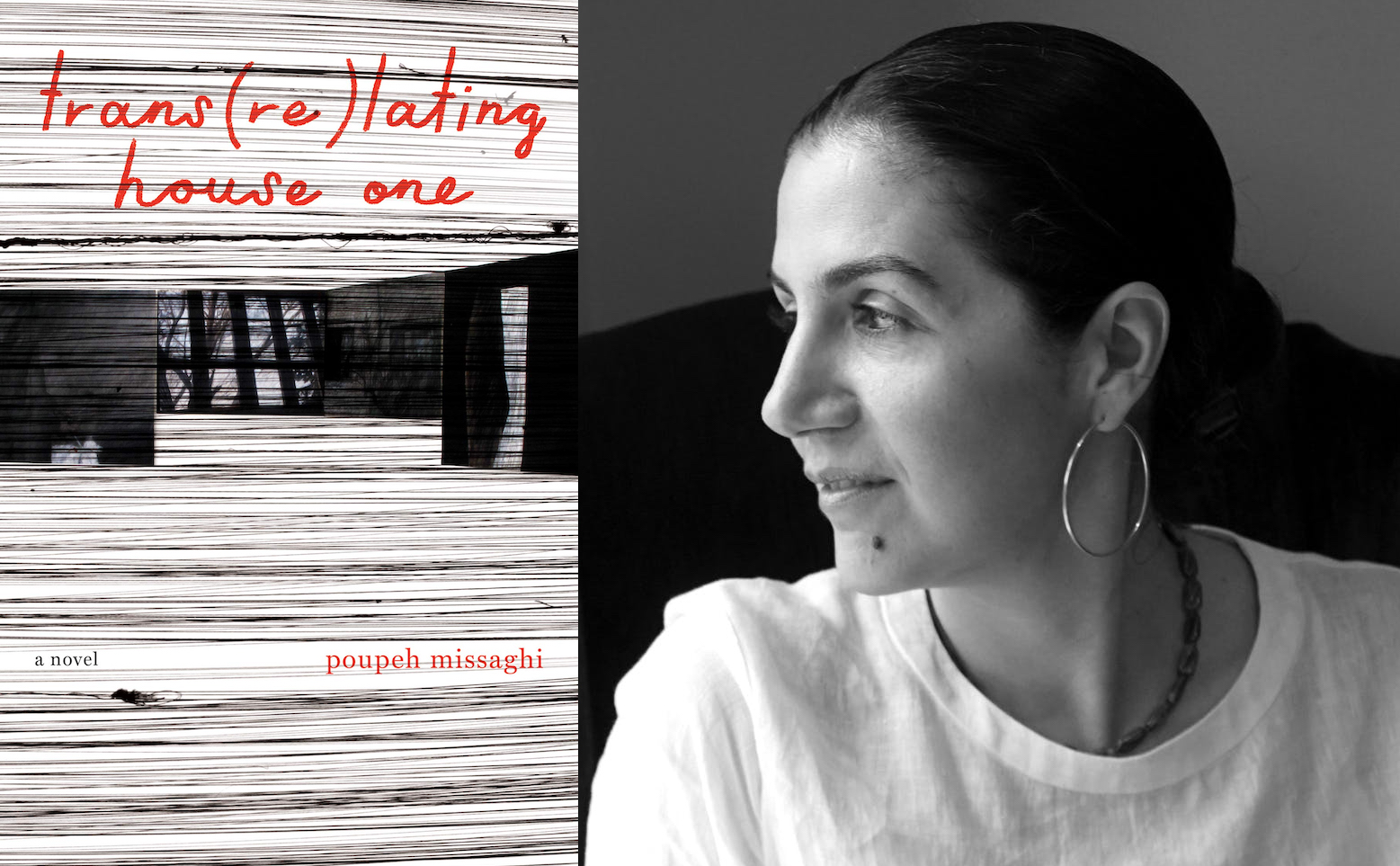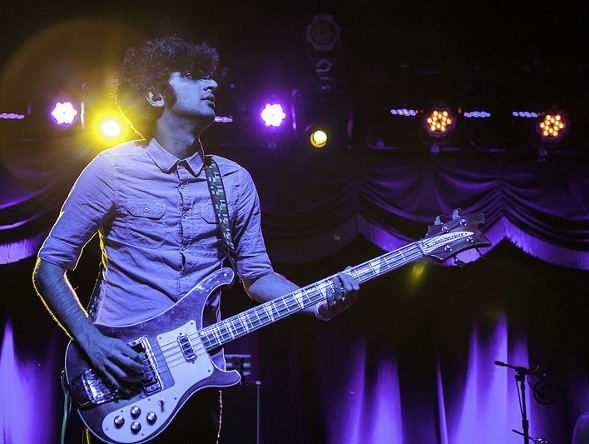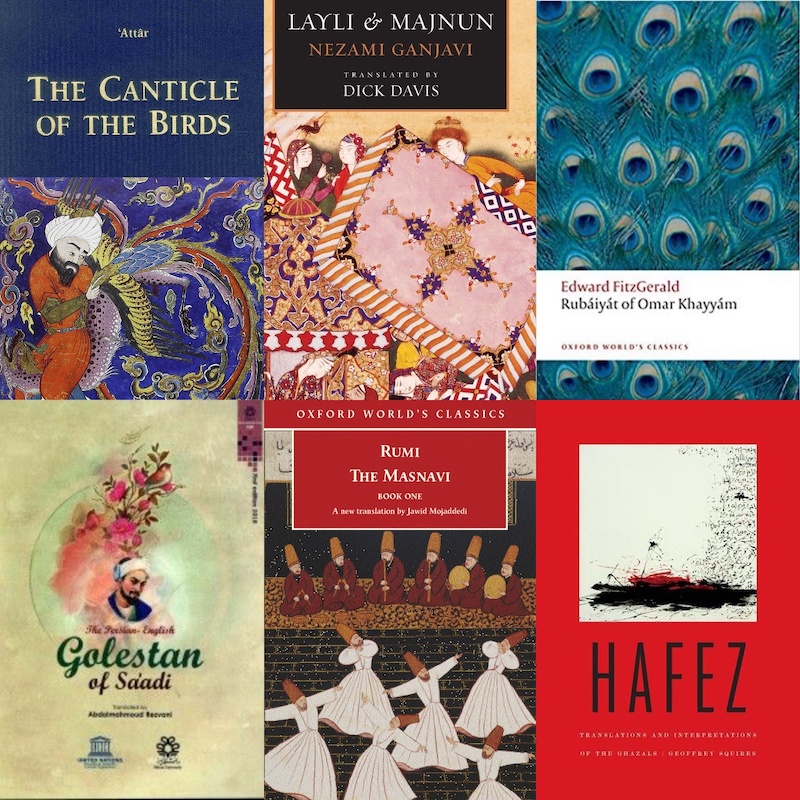The author of trans(re)lating house one talks translation, mapping Tehran, and writing through the aftermath of Iran’s 2009 election.

February 6, 2020
“Looking for certain narratives of backwardness and victimhood, they pay attention to sociopolitics instead of aesthetics, instead of not alongside. A neo-orientalism bolstering the existing narrative of the Other who needs to be pitied, or feared.”
—from trans(re)lating house one
Poupeh Missaghi has been working as a translator for years, but her debut novel, trans(re)lating house one (Coffee House February 2020) works with translation in whole new ways. Translation, in Missaghi’s hybrid novel, is not just the act of moving from one language to another, but also the attempt to render reality into static language, move ongoing events into memory and historic record, traverse borders of fiction into nonfiction, and complicate the space between witness and authority within narrative storytelling.
trans(re)lating house one is, at its simplest, the story of a Tehrani woman who, sometime after the social and political upheaval of 2009, has noted the disappearance of public art pieces. Her search for information about the missing statues slowly connects the dots between disappeared art and disappeared people. In between moments of revelation are the moments of her life: friendship, love, work. Woven throughout the entirety of this story, however, is an overstory—the story of the story being told, the story of telling stories like this.
The book trickles through multiple modes, creating a shimmering effect as the reader moves from narrative to metanarrative. We see the unnamed female protagonist sitting on a bus, observing the city and people around her, and on the next page we pull away to hear the “author” speak her desires for the character and the narrative. Our focus moves back and forth between these two several times before being interrupted by “facts”—a description of a missing statue, a quoted passage about the function of public art. Eventually, in roughly the same format as the descriptions of the statues, human corpses appear—though they are accompanied by simple, affecting narratives. Image-text is also introduced, often in relation to discussions of dreams and their relation to the reality of the story being told and the creation process of the storyteller. The overall effect can be disorienting, but intentionally so. Missaghi takes us through the layers she’s crafted gently, with a radical commitment to transparency as she shares every narrative choice—made and unmade—on the page as we read along.
Central to the story is uncertainty. Questions—the character’s, the author’s, and the reader’s—generate the majority of the momentum, despite the ostensible mystery of the missing statues and the missing bodies. The importance of asking these questions, here and now, as we follow the story, is unmistakable—without the guidance of questions, any statement can come across as a fabrication. But with the ceaselessness of questioning, Missaghi reaches a place within printed text for movement. Even in the past few weeks—as aggression towards Iran has soared and, with it, the attention of Western imaginations—the questions posed by trans(re)lating seem to have changed their tone and meaning.
“Is having lived through this era, in this place, in this injustice, justification enough for choosing to tell this story and not those of other moments and sites of oppression and repression?”
—Amanda Ajamfar
Amanda Ajamfar: Is there a narrative about how this novel got started?
Poupeh Missaghi: It actually started as different projects while I was in the PhD program in Creative Writing at Denver University. I was thinking about how we translate reality into text. And one project was translating the city and the other was thinking about the bodies. I was looking at them as separate projects. And the dreams were completely separate. And then at some point they just became one project.
AA: There are so many forms, and so many layers, and so many shifting patterns, and the content of the book is also talking about all those things. Was the creation process very analytical or was it more a feeling? Were you able to feel what should be next to each other or when to leave a form behind?
PM: Feeling played much more of an important role. I would say I decided where sections should go primarily by how it felt and how I wanted my reader to feel. And that was one of the reasons some of the sections were moved around or added later in the process as well. Like when I had all of the corpse sections together, I was also feeling like this could be so overwhelming. I have written this over a few years, but if someone is to read all of this together this can be problematic, right? Or if you are reading all of the questions together, would it be as impactful as it is? So, it was mostly like, this is how it feels, and this is analytically what it could mean.
AA: So, every time the external content sort of comes in—sometimes it’s by itself, sometimes it’s just a quote from another book, and sometimes it’s with a little bit of this meta-author sort of contextualizing it—that all came from your time in your PhD program?
PM: Mhm. But not exactly in this format. The research that I had done for it was though while I was in the PhD program.
AA: What was that process?
PM: The dissertation that we had to submit had two sections—one was the creative section, which was the novel, and then the other one was the critical theoretical section in which we had to do research, read theory, and write more of an academic essay. So, a lot of the material that found its way into the meta-layer of trans(re)lating house one, I pulled out from the academic explorations of my dissertation.
AA: How does your translation work affect your creative fiction writing?
PM: In so many different ways. I worked as a translator before I worked as a creative writer. One of the important people who has influenced this book is Roberto Bolaño. I translated his collection of short stories Last Evenings on Earth into Persian, and since that book, I became obsessed with him. So, in a way, through that translation, his style and his voice became important in my own writing. So that’s one layer.
The other layer is, for example, the city layer. The way I see it, I’m not really writing; I’m just translating what I’ve seen. It’s also translation of a reality that is happening in another language. Then there is translation of all these different art forms that I’ve seen. So, I’m translating visual art into text as well.
With the corpses layer, all of that information is online, mainly in Persian. I’m just combining them and documenting what already exists in this other language. So that was also another translation.
And then the dreams are another layer of translation in its own way.
AA: Can you talk more about the dreams part? The dreams seem really strongly associated with the image-text—as I was calling them—sections. Can you talk about what this was, how this was made, and how they relate to the dreams?
PM: The images are the result of my dream diary that I kept for a few years. I wanted the text to be part of this book because I decided the dreams were a part of this history but on a different level. I had more than 100 pages of notes. And then I was talking with Laird Hunt, my dissertation director, and he was like, “What if you look for patterns and repetitions in the text and see what those show you?”
I ended up using a word cloud generator and I realized I could play with the forms. Just playing with them I came up with these 13 shapes, and what I did was have a friend who is an artist draw what I had generated by the computer, using a calligraphy pen.
AA: Can you talk a little bit about the title?
PM: “house one” comes from the dreams. A lot of my dreams happen in my childhood house in Tehran, so “house” is one of the words that is repeated most in the dream journal. And “one,” in reality, it appears so much because I had written phrases like “one does this,” “one goes here” “one sees this”—so just that unclear subject in the dreams. But then when it appeared like this in the word clouds I was like, this also totally makes sense, because your childhood house is your first house and I also read it as being the homeland. So, I decided to actually keep it like this.
And then “transrelating”: I was sure that I wanted translation as part of the title because as I said I see the book as a translation on many levels. But also, it’s “relating”—in the sense of “narrating” this topic. It also allows a “relating to,” because I’m letting my readers relate to it while I’m also relating to the topic and to the readers. And I wanted it in that “–ing” format to show process. I didn’t want “transrelation,” I wanted “transrelating.”
AA: You wanted that form of the word because it’s ongoing?
PM: It’s ongoing, it’s process, it’s verb, action.
AA: How do you think about audience as you’re writing?
PM: I knew that my readers would be English speakers, eventually. And within that English-speaking group, I knew that I didn’t want an audience that is interested in mainstream stories of Iran. I wanted more of a complicated reader who is not necessarily just interested in social, journalistic narratives, but more in literary form and story.
AA: There’s a meta moment in the novel that talks about how international film festivals look for certain kinds of narratives—and it feels like that discussion could be applied to books as well.
What were some ways that you chose to navigate that when writing this subject matter? Knowing what people—what white or American audiences—tend to look for and how you want to write about certain things.
PM: One of the important choices that I made was to bring in the questions. It was a direct result of that concern. I kept thinking, “Okay, I have written this work. I know that my intentions are for it to be read differently than what is usually expected of stories from Iran.” But I also knew that was just wishful thinking. That doesn’t necessarily happen. I had a lot of doubts or concerns, like, “Okay, how could it be received differently? Or what kinds of conversations could happen around it that could be more complicated, rather than going back to that cliché narrative?”
And that’s why I was so happy with that decision to bring in the questions. Instead of thinking, “Okay, these are my concerns, hopefully we’ll talk about them,” the questions being there made it clear that these conversations are actually a very important part of the whole narrative of the book. They are not just a separate conversation that, hopefully, will happen one day.
AA: I read the use of translating as indicating the view that all storytelling is a form of translation. Do you see differences in translation as a concept when it’s fiction versus nonfiction?
When you knitted together the stories of the corpses, you didn’t find one single article that you were able to use in its entirety. So, when “translating” those into a coherent whole, is there a formal difference or different choices you’re making versus when your translating (as in all storytelling is translating) fiction?
PM: I wanted to be as accurate as possible, but at the same time the sources themselves were sometimes so contradictory. There were so many different narratives about one person or one event that at some point you realize that even reality is becoming fictional. Depending on what source you’re going to, it’s a different story. And because one of the aspects of the book is making the borders between fiction and nonfiction more confusing, I don’t know if I can say, “Whenever it was nonfiction, I decided to do this, whenever it was fiction, I decided to do this other thing.”
But with the narratives of the city I gave myself more liberty for sure. Sometimes it becomes just so surrealist or magical realist, right? With the corpses, I didn’t want to go there. I just wanted to be grounded in reality.
So maybe in that sense, I was staying closer to reality in the nonfiction layers, while knowing that reality itself might have been fictionalized. But with the fiction parts, I wouldn’t limit myself to any boundaries.
AA: How did you come to the cover art?
PM: That’s an interesting story actually. The artist for the cover, Sara, she is my childhood friend. While I was discussing the cover with the editors at Coffee House, I suggested two other works of hers. I also sent a link to her website. And they saw what would later become the image used for the cover in another of her work series, and they said, “What do you think about these”?
And interestingly I work with Sara a lot. Sometimes I help her edit or translate her artist statements, and so when I went to the page, I realized that this series was actually one of the ones that I had helped her with the statement. I could hear traces of my own voice and see my translation in the text next to these images.
The image used is actually a picture from an installation that she did. The frames are her paintings on walls, and then the threads are threads she had woven from wall to wall in front of the paintings, and then she took a picture of them. So, in a way, this is also a translation, I could say. Like we have paintings that are translations of reality and then a picture of an installation including them.
And if I’m not mistaken, some of these paintings—I mean all of them are from Tehran—but she used to have her art studio in my parents’ house and I’m thinking that at least one or two of these she painted while she was in that room.
AA: There are a lot of art pieces described in the book—films, statues, exhibitions—were they all real ones or were any invented?
PM: I don’t remember any that were invented; I think all of them were things that I saw. Even if they became fictionalized, there was something in reality that I took from. If you also think about the corpses section, I wouldn’t be able to write those sections without all the work that has been done to collect that information. Then, if you think about the quotes that I’m bringing in, that’s also like I’m in conversation with the larger literary community. So, in that sense these are all some form of translation and indirect collaboration.
AA: There’s clearly so much creative work and so much layering, but it also just felt in a lot of ways full of ideas and very academic in some ways. One thing you hear a lot in writing classes is that when you start a story or a novel you have to teach the reader how to read what you’re writing.
How did you think about that? Did you do anything formally, or did you have any techniques that you used, in order to help the reader figure out and stay on track throughout, or at the very beginning to help introduce what they’re going to be doing?
PM: Well maybe parts of the meta layer are doing that. But I wanted that feeling of being lost to remain there to some extent, because I felt lost writing it. And I think it’s also a reading experience in which you need to be lost. So, if it became very easy to navigate then it would just defy the purpose, and I didn’t want that.
AA: You really trust your readers to keep up with you.
PM: I do, but I also think there is a possibility that I would lose some readers because of that. I know this is an intense narrative. How would you experience something like this in life without feeling lost in it?



